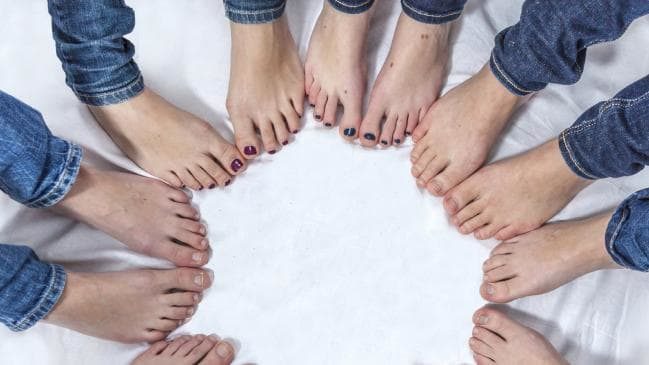
Now there's a new core workout that promises all of these gains and more. And what's surprising is that the core muscles being targeted are not to be found in your trunk, but in your feet.
Improving foot core stability is the latest fitness target among those preoccupied with avoiding rounded shoulders and back pain. Last month, it was a focus of the podiatry and orthotics lectures at the Primary Care and Public Health conference in Britain.
Matt Fitzpatrick, the chairman of the conference and a consultant podiatrist at the UK College of Podiatry, says that, for too long, our foot muscles have been neglected. In much the same way as in the muscles of the trunk, he says there is a complex structure of muscles in the foot's core that work together to support the body.
"Our feet comprise four layers of muscle and soft tissue," Fitzpatrick says. "There are muscles at the top and bottom of the foot that help to lock it into place and keep us upright."
A strong, healthy foot has a moderately high arch, no overpronation - rolling inwards - and some natural spreading of the toes. In a paper published three years ago in the British Journal of Sports Medicine, a team of Harvard researchers define the central core of the foot as the range of muscles intertwining to maintain this raised arch, providing us with the stability needed to hold us in good posture or to support even the most basic movement patterns, such as walking.
"We would like to suggest that perhaps it is time for the decade of the foot," the researchers wrote. "This type of attention is largely ignored but critical."
In evolutionary terms, the foot developed in response to the demands placed on it as humans walked and ran. Its intricate musculature connects to muscles in the ankle, lower leg, back and abdomen.
"When we are doing something as simple as standing up, it is the feet that act as a solid base," says Fitzpatrick. "When we walk or run, it is the muscles in the feet that provide the ability to push off and move forward." Like any other muscle, when the foot's core is underused it becomes weak and unable to function as it should.
As the Harvard researchers put it, our "foundation becomes unstable and malaligned" and the result, at the very least, can be foot-related RSI and chronic pain. With diminished strength, the foot arch can drop or collapse, potentially leading to strain of the plantar fascia - the thick, supportive band of tissue that runs across the bottom of your foot and connects to your heel. That can trigger pronation of the ankle and unusual forces being placed on the knee joint. Over time, a weak foot core can be implicated in reduced walking efficiency and range of movement, or worse. "It can lead to problematic things like chronic plantar fasciitis, tendon dysfunction and even osteoarthritis," says Nick Holowka, a researcher in the department of evolutionary biology at Harvard.
Despite this, our feet remain the last body part we think of working at the gym. There are no classes to strengthen the foot core muscles, no foot equivalent of the pilates reformer. So what should we do? A daily regimen of exercises is key.
"Perhaps the simplest thing we should all do is to try to pick up things with our toes," Fitzpatrick says. "Take off your socks and wriggle your toes, then try to pick up something like marbles. Ballerinas have the best foot strength and they train their muscles by doing this kind of thing 50 or 60 times a day."
Paul Hobrough, a chartered physiotherapist and sports scientist, says simple moves such as writing the alphabet with your toes or grabbing a towel with your feet are also great for developing foot core stability. And evidence has pointed towards daily practice of what podiatrists call the short-foot exercise, or foot "doming", in which you use the foot muscles to create a dome by pulling the toes toward the heel and elevating the arch, being helpful.
In Nature's Scientific Reports journal in February, Holowka and his colleagues suggest that the shoes we wear often do nothing to help foot strength. "Wearing supportive or restrictive footwear reduces the role of the foot muscles, leading to less growth and less strength," he says. "Any shoe that constricts the natural motion of your toes, your arch, or your ankle could be considered a shoe that limits the amount of work muscles perform to control the stability of your foot and ankle."
That includes not only high heels, which force the feet into an unstable position and put pressure on the plantar fascia tissue, but overconstructed trainers and insoles that give so much support for the foot arch that the muscles have little work to do to keep it raised.
"If you already have flat foot or overpronation or other afflictions that cause foot pain, stick to your shoes or insoles or whatever helps you minimise that pain," Holowka says. "But if you don't have any of those problems, you should try easing your way into using less structured shoes. Based on our data, and that from other studies, we cautiously suggest that minimalist shoes - those with no in-built arch support - and sandals are ideal in helping to maintain a strong, healthy foot."
That doesn't mean ditching your shoe collection. The Harvard scientists suggest that some barefoot walking around the house can be used "as a tool to strengthen the foot core" in those who are not suffering existing pain. Fitzpatrick agrees. "I'm wearing shoes now," he says. "But the very first thing I will do when I get home is kick them off. Work your feet muscles in any way you can. It really will pay off."



Comment: The benefits of bare feet